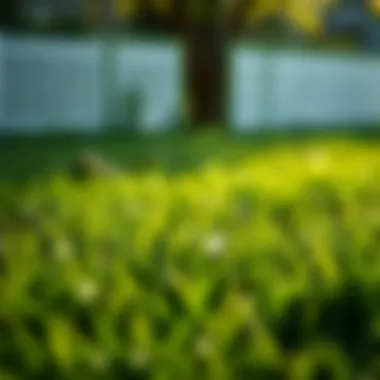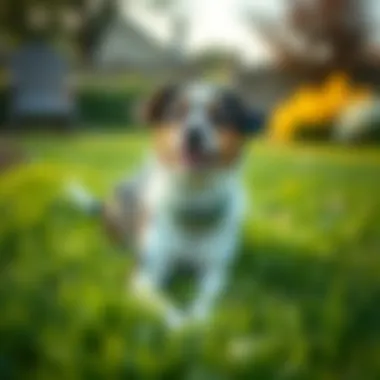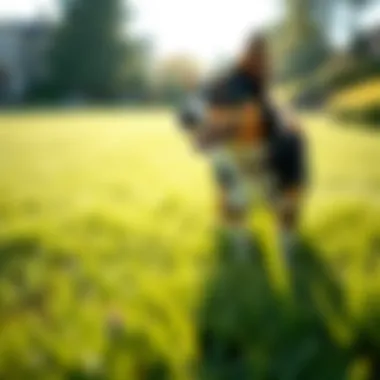Effective Strategies to Restore Grass After Dog Urination


Intro
Dog ownership brings immense joy into lives, but it also comes with its own set of challenges. One of the most pressing issues is how to maintain a healthy lawn in areas where dogs frequently urinate. Dog urine contains nitrogen, which in concentrated amounts can scorch grass and leave unsightly brown patches. While this is a common concern for many pet owners, there are effective strategies to rejuvenate and cultivate grass in these affected areas. This article delves into practical approaches to lawn care, explores suitable grass types, discusses necessary soil amendments, and offers preventative measures to minimize future damage.
Understanding the intricate dynamics of dog behavior and its impact on lawn aesthetics allows pet owners to restore their lawns while still catering to their furry friends. Let's navigate through the critical aspects that will help you maintain a beautiful lawn without compromising on your dog's needs.
Understanding Dog Urine and Its Effects on Grass
The Science Behind Dog Urine
Dog urine acts like a potent fertilizer, primarily due to its high nitrogen content. While nitrogen is essential for grass growth, too much of it, particularly in concentrated forms, can lead to ‘burn’ spots. These areas of grass exhibit a yellowish-brown coloration and can vary in size depending on how often a dog relieves itself in that spot. Over time, these unhealthy patches compromise the overall appearance of a lawn, making it appear patchy and neglected.
Identifying Affected Areas
Recognizing where dog urine has damaged the grass is the first step toward remediation. Usually, the areas where dogs tend to urinate frequently become barren or show signs of distress.
- Yellow Browning: The first sign of damage due to urine exposure.
- Dead Patches: Areas that have lost their ability to sprout new growth.
To effectively tackle these problem spots, it’s essential to implement a systematic approach to lawn care.
Practical Approaches to Lawn Care
Selecting Appropriate Grass Types
When looking to cultivate grass in areas where dogs have urinated, choosing the right species is crucial. Some grass types are more resistant to urine damage than others. Consider the following options:
- Perennial Ryegrass: Known for its rapid germination and recovery.
- Tall Fescue: This has a deep root system, making it more resilient.
- Bermudagrass: Good for sunny areas, though it can be invasive.
Selecting the appropriate type ultimately depends on your geographical location and climate conditions.
Soil Amendments for Recovery
Improving the soil structure can help the grass bounce back better. The addition of organic materials, such as compost and peat moss, enhances fertility and moisture retention, providing a balanced environment for the grass to thrive. Acidic soil can be treated with lime to adjust the pH, creating a more favorable growing medium for grass.
Regular Lawn Maintenance
An established routine for lawn care, including watering, mowing, and fertilizing, plays a significant role in grass recovery. Watering the impacted areas thoroughly after each urination helps dilute the concentration of urine, mitigating its harmful effects on grass. Mowing regularly and at the correct height can also promote overall health, encouraging denser growth that can better withstand occasional urine exposure.
Preventative Measures for Future Protection
Designating a Potty Area
To protect valuable grass, consider training your dog to use a specific area of the yard for urination. By designating a potty area, you can protect your main lawn while still catering to your pet's needs. You can opt for gravel or mulch in this area, which tolerates urine better compared to grass.
Implementing Watering Schedules
Adjusting your watering schedule to include frequent watering after your dog urinates is key. This not only dilutes damaging compounds in the urine but also promotes the recovery of affected grass.
Ending
Understanding the Problem
Grasping the intricacies behind grass damage due to dog urine is crucial for anyone who’s both a dog lover and a lawn caretaker. It’s not just about the unsightly brown patches marring your otherwise well-maintained lawn; there’s a broader ecosystem at play. Recognizing how canine habits affect turf health can be the first step towards creating a resilient, flourishing lawn that's easy on the eyes and friendly to your four-legged family member.


The Impact of Dog Urine
Dog urine can be an elusive menace for gardens and lawns. Its primary culprit is nitrogen, a key ingredient found in fertilizers that promotes growth in controlled amounts. However, a dog’s urine often deposits this nutrient in extreme concentrations, leading to harmful effects. You may notice certain areas develop a rich green hue, while others turn crispy and brown. The difference between a healthy plant and a stressed one can be as subtle as an imbalance in nutrient levels.
Additionally, the high acidity of dog urine can elevate the pH of the soil, creating a hostile environment for grass. Just like how some people can’t grow cactus in a swamp, your grass may hate this acidic cocktail, leading to potential demise.
"A patchy lawn isn’t merely an eyesore; it’s a sign of a more complex interaction between soil, plant, and what our pets leave behind."
Common Grass Species and Their Vulnerabilities
Not all grass is created equal when it comes to handling the ravages of dog urine. Kentucky bluegrass, for example, is a popular choice, yet it's more susceptible to damage from concentrated nitrogen. On the flip side, fescue varieties, like tall fescue, show resilience against urine damage thanks to their deep roots and drought tolerance.
Know your lawn's makeup. If you're in a region where dogs roam freely and bathrooms are backyard havens, you might want to shift towards hardy species that can withstand the tumble of everyday pet life. Likewise, grass types such as zoysia can handle foot traffic and minor their mishaps from our furry companions better than others.
Identifying Symptoms of Lawn Damage
Recognizing early symptoms of lawn damage is like catching the sniffles before the flu sets in. Look out for three main signs that could indicate your grass is feeling the brunt of dog urine:
- Discoloration: Areas where urine hits tend to turn yellow or brown, resembling patches of neglect amid a green landscape. Best to take a closer look when you notice any shifts in color.
- Texture Change: Healthy grass has a certain lushness to it. If you feel rough patches or see thinning blades, your grass could be crying for help.
- Foul Odors: A poor lawn may sometimes come with its own bouquet. If your garden has a stench that would make even a skunk wrinkle its nose, it might be time for some serious lawn care.
Understanding these signs can lead to timely intervention, mitigating further damage and creating a plan for restoring your green space. The sooner you catch these symptoms, the better equipped you'll be to address the underlying issues.
Soil Conditions and Grass Health
The health of your lawn isn’t just about which grass seed you choose, it’s also intricately tied to the soil conditions beneath it. Understanding the relationship between soil and grass is crucial, especially in areas where dogs frequently urinate. The nutrients, microbes, and chemical balance within your soil can make or break your efforts in maintaining a robust and lush lawn. It’s not only about remedying the damage done by dog urine but also about nurturing a thriving habitat conducive to grass health.
Understanding Soil pH
Soil pH acts as a litmus test for grass health. It determines how well grass can access nutrients, impacting its vitality. Generally, grass thrives in slightly acidic to neutral soil, with a pH ranging from 6.0 to 7.0. If the pH swings too far toward acidic or alkaline, grass varieties may struggle to absorb essential nutrients.
When it comes to dog urine, the nitrogen content can significantly affect soil pH over time, often pushing it towards alkalinity. Testing your soil pH is a straightforward first step you can take. Kits are readily available at garden centers or lawn care stores. Once you have a reading, you can amend your soil with lime to raise pH or sulfur to lower it depending on your findings. This careful balancing helps your grass to flourish, even in areas where dogs do their business.
Nutrient Deficiencies and Surpluses
Effective lawn care requires a close eye on nutrient levels. Grass needs a variety of nutrients to thrive, including nitrogen, phosphorus, and potassium. However, excessive nitrogen from dog urine can lead to an over-fertilized lawn, characterized by lush patches surrounded by brown areas. This uneven growth not only looks unsightly but also can weaken the grass, making it more vulnerable to disease.
Spotting nutrient imbalances is simpler than you might think. Symptoms such as yellowing grass could indicate nitrogen deficiency, while burned tips and bright green patches might signal over-fertilization. Fertilization strategies such as periodic soil tests and targeted amendments can help create a balanced nutrient profile that benefits both your grass and the environment.
Microbial Activity in Soil
The unsung heroes of a healthy lawn are the microbes in the soil. These tiny organisms contribute to breaking down organic matter and cycling nutrients, helping to maintain soil structure and fertility. Healthy microbial activity is essential, especially in dog-urinated zones, as canine urine can disrupt the microbial balance, leading to unhealthy soil conditions.
Promoting microbial life can be done through various methods. Practices like avoiding chemical fertilizers, incorporating compost, and ensuring adequate aeration can help. Aeration allows for better air flow, crucial for microbial health. Additions of organic matter can also enhance microbial colonies, making your lawn more resilient in face of dog urine stress.
Remember that a thriving lawn is a team effort between soil and grass. Pay attention to how they interact and the consequences of one’s health on the other.
Choosing the Right Grass Type
Selecting the appropriate grass type is critical when it comes to cultivating a vibrant lawn where dogs frequently urinate. Grass species can greatly influence not only the aesthetics of your yard but also its resilience against the harsh effects of canine urine. Moreover, specific types are better equipped to withstand both the nutritional imbalances caused by dog waste and the physical stress from trampling. This aspect holds significance for families who wish to maintain their lawns while keeping the happiness of their pets in consideration.
Drought-Resistant Grass Varieties
Opting for drought-resistant grass varieties can be a game changer, especially if you live in an area where water conservation is key. Varieties like Bermudagrass and Zoysiagrass exemplify this trait, thriving in hot, dry conditions while requiring less frequent watering. As urban landscapes face increasing demands for water, these grasses not only protect local water resources but also provide robust options for those lawns battered by dog urine.
- Bermudagrass: Known for its ability to flourish in sunny climates; its aggressive growth can outcompete weeds, leading to denser, healthier grass.
- Zoysiagrass: This type can endure foot traffic and is highly drought-tolerant, adapting well to different soil types.


Drought-resistant grass types can withstand the extra stress from pets, allowing them to recover quicker from both moisture deprivation and urine exposure. Establishing these varieties in your yard invites a durable and environmentally conscious relationship between your lawn and your canine companions.
Grass Species Resilient to Dog Urine
When addressing the challenge of turf affected by dog urine, selecting species that exhibit resilience is paramount. Certain grasses have a natural tolerance or even beneficial characteristics that can mitigate the negative impact of urine. For example, both Tall Fescue and Kentucky Bluegrass show promise.
- Tall Fescue: Renowned for its deep root system, this grass can absorb water efficiently and recover from stress. Its tolerance to canine byproducts makes it an ideal choice.
- Kentucky Bluegrass: While it may not be as hardy as Tall Fescue, its ability to self-repair via underground rhizomes helps patch damaged areas, which is valuable in maintaining a cohesive lawn appearance.
Choosing grass species resilient to dog urine fosters an environment that can withstand not only the biochemical effects of the urine but also the physical wear and tear from playful pets. As the lawn adapts and thrives, a luscious, green space remains a constant source of pride for homeowners.
"Selecting the right grass species is like choosing tools for a job; the right one can make all the difference in ensuring success."
Making informed decisions about grass types, particularly those drought-resistant and resilient to dog urine, brings the promise of a healthy lawn. Such choices help to integrate the needs of both the grass and the dogs, allowing them to coexist without compromising on visuals or turf integrity.
Lawn Care Practices
Caring for a lawn subject to frequent dog urination requires strategic action. The impact of canine urine generates stress within grass, leading to unsightly patches and potential die-off. Lawn care practices are essential in addressing and reversing these effects. This section highlights effective techniques, ensuring that a balanced environment is achieved for both grass and pets.
Watering Techniques to Dilute Urine
One of the most straightforward methods of mitigating the effects of dog urine is to enhance the watering regimen. Watering your lawn promptly after your dog does its business can significantly dilute the concentration of nitrogen and salts present in urine.
Here are key considerations:
- Timing is Key: Water immediately after urination to wash away harmful compounds.
- Deep Watering: Use deep watering techniques. This will ensure that water penetrates the soil and reaches the grassroots, aiding not just in dilution but in nourishing the grass.
- Hydration Schedule: Consider setting up a schedule to water at regular intervals, especially during dryer months.
By blending these techniques, you can manage the effects of urine and keep the lawn healthy.
Fertilization Strategies for Recovery
Once the lawn shows signs of distress from dog urine, it's vital to apply thoughtful fertilization. It's essential to counterbalance the high nitrogen levels from urine with the right nourishing elements. Here are some effective strategies:
- Slow-Release Fertilizers: Use slow-release formulations that provide nutrients gradually and prevent an immediate spike in nitrogen.
- Balanced Nutrient Ratio: Choose fertilizers with an NPK ratio suitable for your grass type, typically aiming for balanced numbers like 10-10-10 or 20-20-20.
- Testing Soil Health: Conduct a soil test prior to fertilizing. Understanding your lawn’s nutrient levels will help in making an informed choice on what products to use.
Fertilizing with intention can promote grass recovery and repair nutrient imbalances caused by dog urine.
Aeration and Soil Compaction
Another crucial aspect of maintaining a healthy lawn is addressing soil conditions, particularly compaction. When soil is compacted, water, nutrients, and oxygen struggle to penetrate, impairing grass growth especially in urine-stressed areas. Therefore, implementing aeration practices can offer the following benefits:
- Enhances Gas Exchange: Aeration increases airflow to the roots, encouraging healthier growth.
- Improves Nutrient Absorption: By breaking up compacted layers, grass can better absorb water and nutrients.
- Prevents Runoff: Aerated soil allows for better infiltration of water, decreasing runoff which can wash away beneficial resources.
Aeration typically involves perforating the soil with holes to allow air, water, and nutrients to penetrate deeply.
Combining aeration with other lawn care strategies enhances the overall health of the grass and creates a resilient lawn environment even in the face of frequent canine visits.
Preventative Measures
When it comes to maintaining a healthy lawn, preventative measures are a dog owner’s best friend. Many may think that being reactive is enough, but those proactive steps can make a world of difference in how grass thrives despite our furry friends' less-than-ideal habits.
Taking the time to train dogs and implement physical barriers can significantly reduce the damage caused by urine, preserving that lush green look while keeping the pet owner serene. The main objective here is to foster a lawn that not only looks good but also provides a safe and enjoyable environment for dogs and humans alike.
Training Dogs to Urinate in Designated Areas


Training plays a crucial role in minimizing lawn damage. By encouraging your four-legged companion to urinate in specific areas, you can significantly control where the concentrated nitrogen from their urine seeps into the soil. To start this training, consistency is key. Here are some useful tips:
- Choose a specific spot: Designate an area in the yard that’s away from your grass, preferably one that’s easy to clean and further from prized plants.
- Use positive reinforcement: Each time your dog uses this spot, reward them with treats or affection. This helps them associate the area with something positive.
- Regular routines: Establishing a regular walk or potty schedule can guide your dog to the designated area when they need to relieve themselves, which builds their habit over time.
Training might take some patience, but it’s an impactful solution. It not only protects your grass but also strengthens the bond between canine and owner as they learn together.
Using Barriers to Protect Grass Areas
Alongside training, utilizing physical barriers can be an effective strategy against lawn damage. Think of barriers as the first line of defense against unsightly patches. Here are some ideas:
- Fencing: One might consider small temporary fences or garden stakes to restrict access to grass areas while allowing the dog to roam somewhere permissible. Look for lightweight materials that offer the necessary containment without blocking the view.
- Planting non-toxic deterrents: Specific plants can naturally deter dogs. Things like rue or licorice plant are often unappealing to pets but provide a lovely garden aesthetic.
- Training aids: Certain products can help redirect your dog from grassy areas. This could include sprays that have scents dogs find unappealing. Make sure to opt for those that are safe for your dog and the environment.
"An ounce of prevention is worth a pound of cure."
Incorporating training and physical barriers into your lawn care strategy can significantly reduce the impact of dog urine, aiding not only in lawn recovery but also in fostering healthier relationships between pets and their environments. By being proactive, the owner can maintain not just a beautiful yard but also a happy and healthy canine companion.
Long-Term Lawn Management
When it comes to nurturing grass in areas frequented by dogs, adopting a long-term lawn management strategy is nothing short of essential. It’s not merely about fixing the immediate damage from canine urine but establishing a sustainable approach that promotes grass health and resilience over time. One must understand that by focusing on the long haul, you're essentially safeguarding your lawn against recurring issues, which can save both time and effort in the future.
Maintaining Healthy Soil Microbes
Healthy soil microbes play a vital role in the overall condition of your lawn. These tiny organisms contribute to nutrient cycling, decomposition of organic matter, and can even improve soil structure. Without a thriving microbial community, the soil can become compacted and unwelcoming for grass growth.
To enrich the soil's microbial life, consider the following strategies:
- Organic Matter Addition: Incorporate compost or well-rotted manure into your soil. This not only provides nutrients but also fosters an environment conducive to microbial growth.
- Avoid Excessive Chemicals: Chemical fertilizers and pesticides can be detrimental to soil microbes. Relying more on organic products can significantly aid in sustaining microbial diversity.
- Aeration Practices: Regular aeration disrupts compacted soil, allowing air, water, and nutrients to permeate deeper, thus supporting microbial activity.
- Mulching: Applying organic mulch can retain moisture, regulate soil temperature, and steadily introduce organic matter, thereby encouraging a healthy microbial population.
An actively thriving microbial community can enhance grass resilience, making it less susceptible to damage from dog urine.
Seasonal Lawn Maintenance Tips
Time is of the essence when it comes to effective lawn management, especially with the changing seasons. Seasonal care offers a strategic approach to enhance the strength of your lawn year-round. Here are some tips to keep in mind:
- Spring Preparation: Post-winter, assess the lawn for any areas where urine damage is visible. Treat these spots early with appropriate soil amendments to restore nutrients and stimulate new growth.
- Summer Care: During the hot months, adjust your watering to ensure grass receives the moistire it needs without becoming oversaturated. Consider using a drip irrigation system which efficiently waters designated areas.
- Fall Fertilization: Autumn is a prime time for fertilization. Choose a balanced fertilizer that encourages root growth and repairs damage sustained over the summer, including from your four-legged friend.
- Winter Protection: If you live in cooler climates, lay down a layer of straw or mulch to protect the grass from freezing temperatures. This insulation can also help safeguard against urine damage by dampening the acidity.
Keeping these tips in mind won't just help your lawn survive but thrive despite the challenges of canine companionship.
"Lawn management is a marathon, not a sprint. Consistency and care yield more than hasty fixes."
Long-term management requires effort, yes, but it can create a more vibrant and resilient lawn that will bring joy for both your family and your pets.
Culmination
The journey to maintain a vibrant lawn in the face of canine mishaps is no small feat, but understanding and effectively addressing the challenges posed by dog urine is crucial for any pet owner. This article serves as a guide to both the problems posed by our furry friends and the solutions available to restore and rejuvenate grass. As dog lovers, our responsibility extends beyond just caring for our pets; it includes preserving the integrity of our outdoor spaces.
Summary of Best Practices
To ensure the best possible outcomes for your lawn, consider the following practices:
- Choose Resilient Grass Types: Opt for grass that can withstand the effects of dog urine, such as fine fescue or Bermuda grass.
- Implement Regular Watering: Immediately after your dog urinates, water the area to dilute the concentration of nitrogen in the urine, which can harm the grass.
- Maintain Soil Health: Regularly monitor soil pH and nutrients to boost the resilience of your lawn.
- Aerate the Lawn: Periodically aerating the grass can help improve air flow and reduce compaction, promoting healthier grass growth.
- Establish Designated Areas: Train your dog to use specific spots for urination, reducing the overall damage to your lawn.
These steps help foster a healthier lawn while accommodating the needs of your pets.
"A well-kept lawn is like a reflection of a responsible pet owner; they go hand in hand."
Encouragement for Responsible Pet Ownership
When it comes to integrating pets into our lives, responsible ownership plays a pivotal role. Not only should we ensure our dogs are healthy and happy, but we must also consider the impact of their actions on our immediate environment. By employing the strategies discussed, we can nurture an outdoor space that is not only functional for our pets but also aesthetically pleasing. Setting aside time to train dogs on where to relieve themselves can greatly reduce lawn damage. Additionally, fostering a routine that emphasizes regular lawn care ensures that our green spaces thrive. This approach benefits not just our grass, but also contributes to a balanced ecosystem that can support wildlife and contribute to local biodiversity.
In essence, taking proactive steps towards responsible pet ownership aligns the well-being of our pets with that of our yards, creating a harmonious environment for all.







